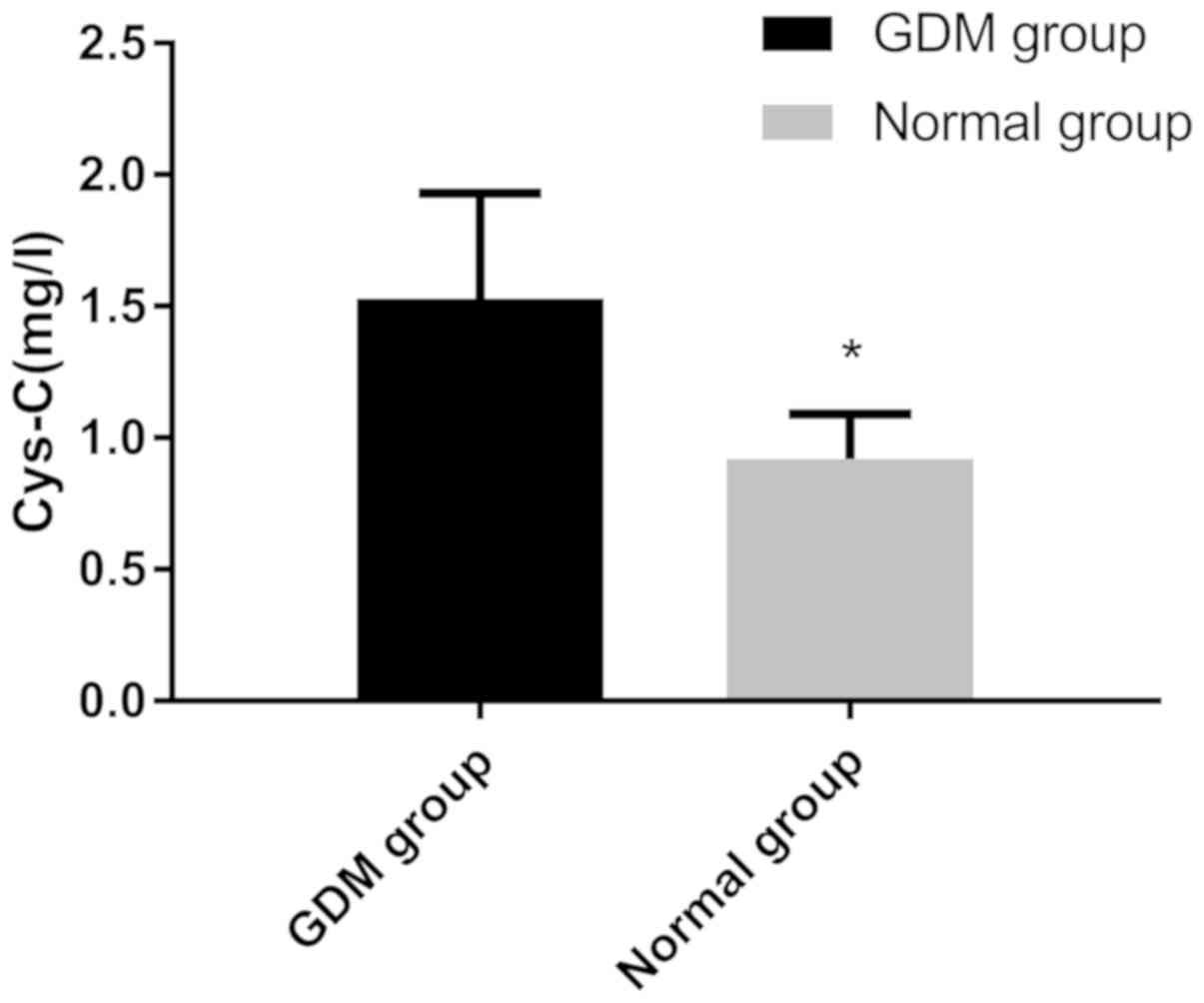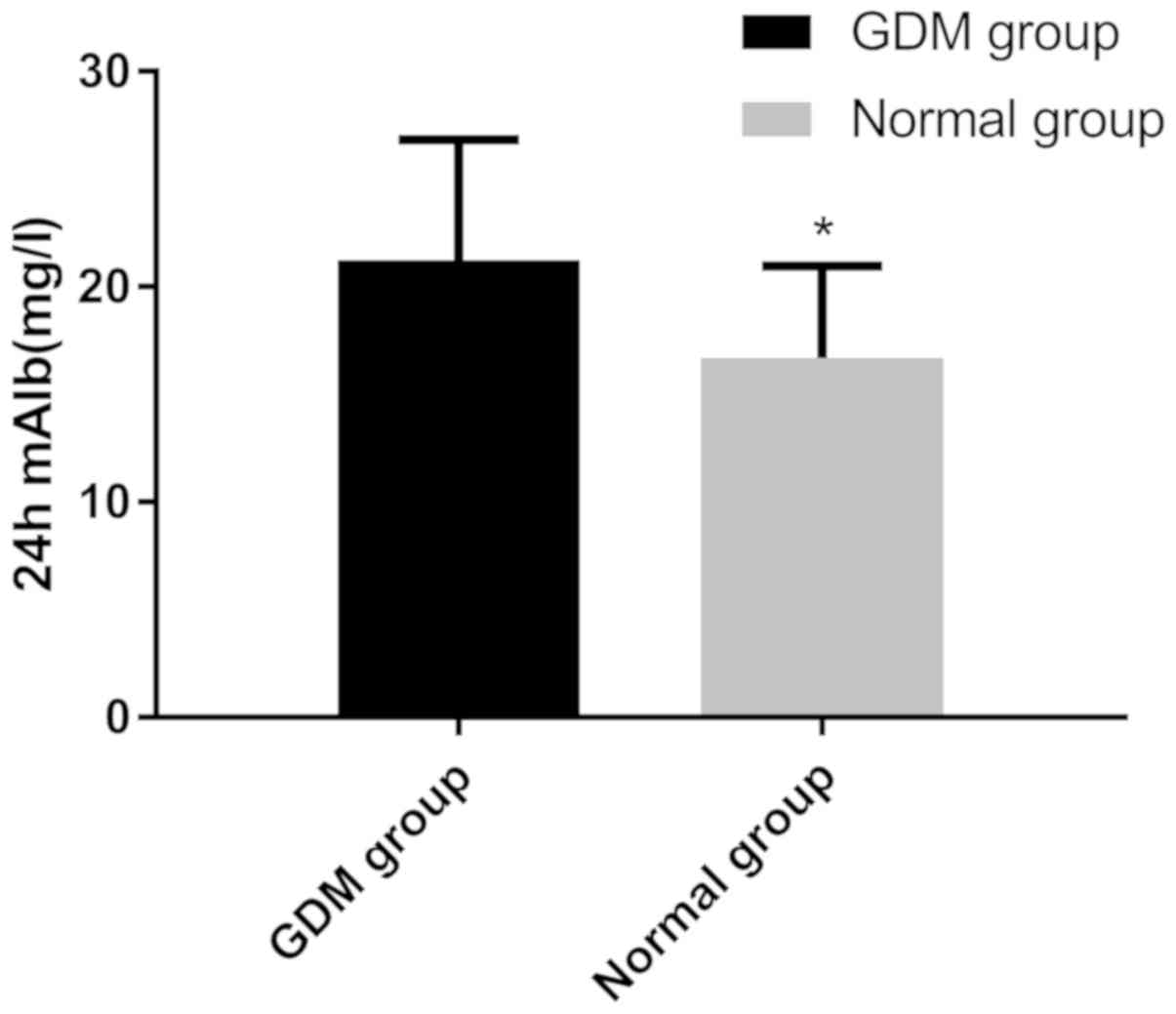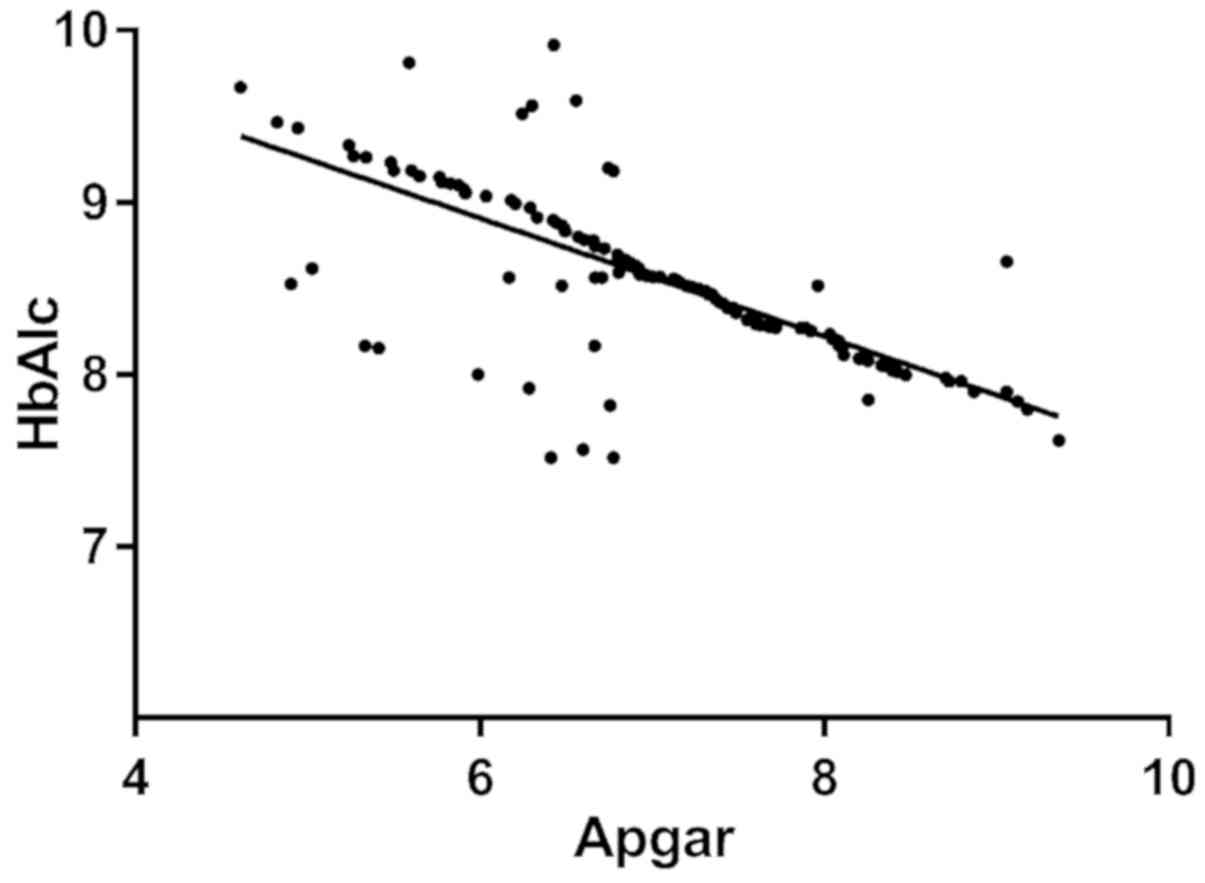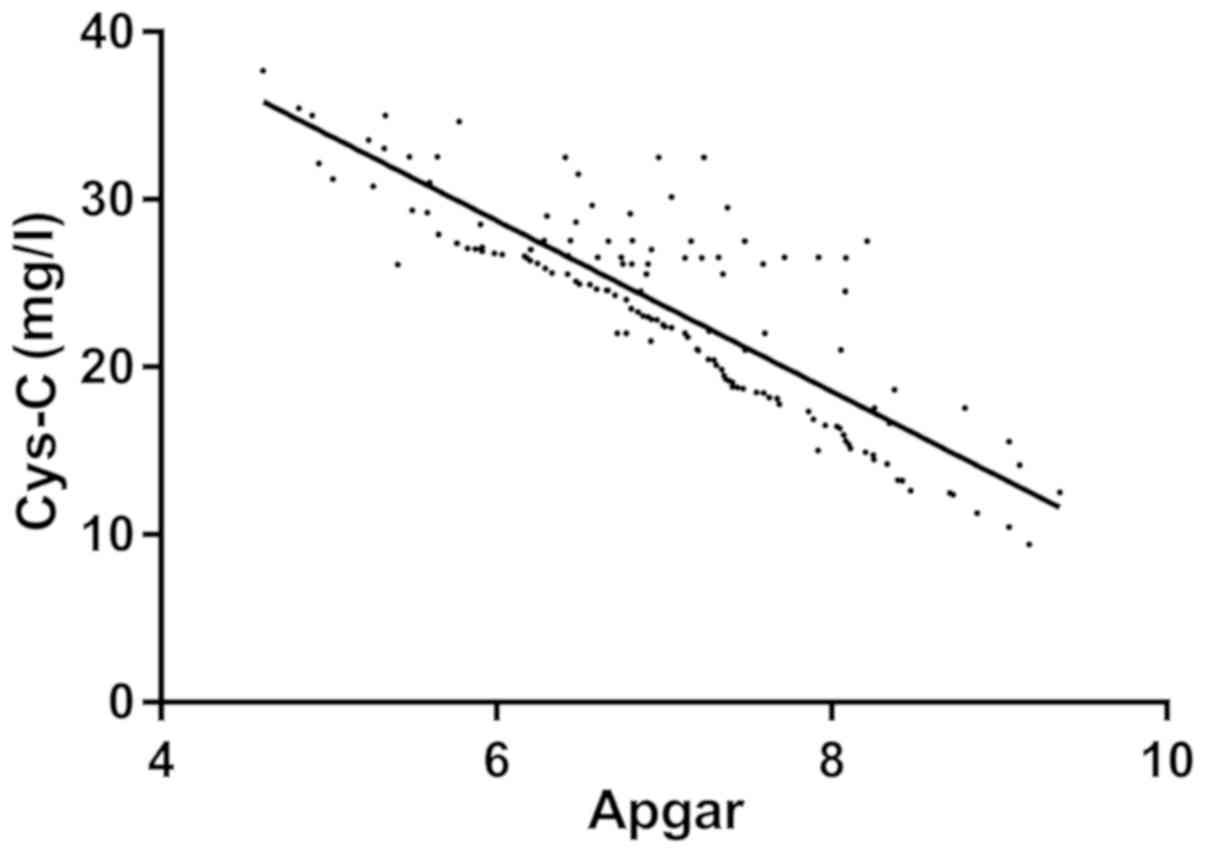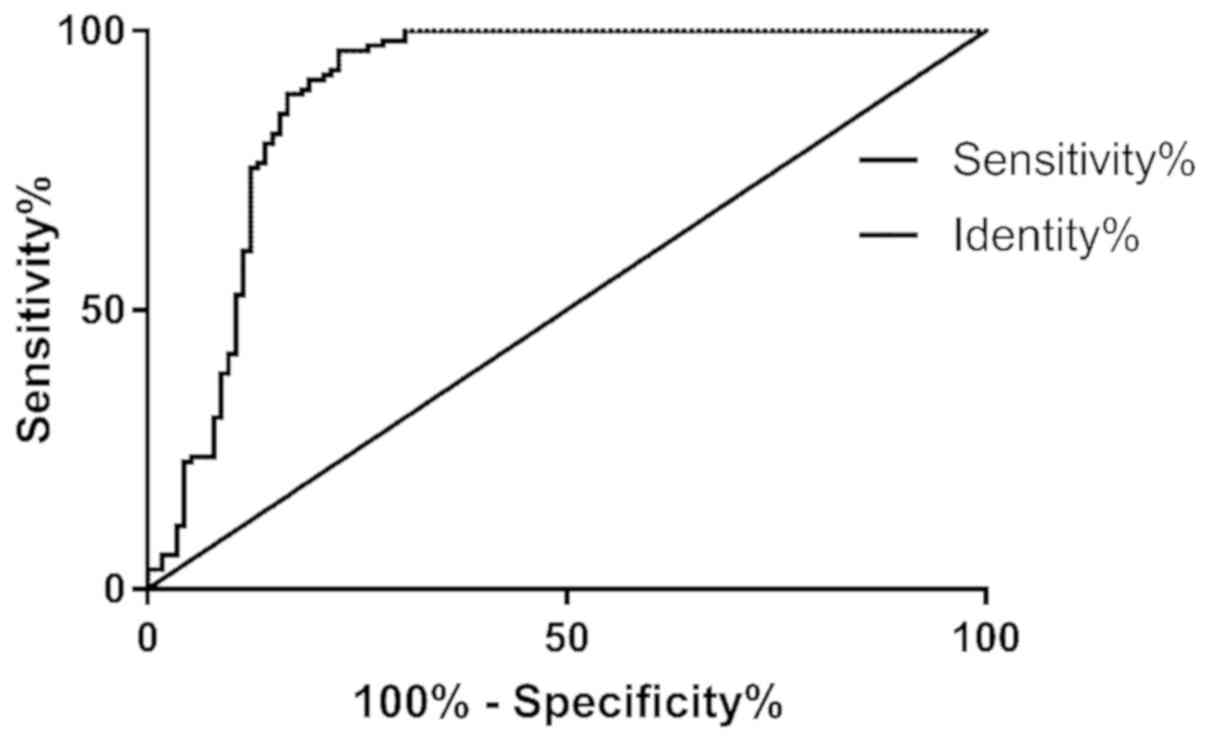Increased levels of glycosylated hemoglobin, microalbuminuria and serum cystatin C predict adverse outcomes in high‑risk pregnancies with gestational diabetes mellitus
- Authors:
- Published online on: December 17, 2019 https://doi.org/10.3892/etm.2019.8336
- Pages: 1281-1287
-
Copyright: © Jin . This is an open access article distributed under the terms of Creative Commons Attribution License.
Abstract
Introduction
Gestational diabetes mellitus (GDM) is clinically classified as a high-risk pregnancy condition (1). In recent years, the incidence of GDM is increasing with continuous changes in living standards and eating habits (2). It has been estimated that 1 out of 15 pregnant females is susceptible to GDM, and in developed countries, including the US and the UK, the incidence of GDM exceeds 10%. The uterus of patients with GDM has a high-glucose environment, which may exert long-term effects on the mother and fetus (3). GDM may greatly increase the incidence of complications during pregnancy, including polyhydramnios, eclampsia and premature delivery. More seriously, it may lead to abortion (4). In addition, the probability of fetal malformation and developmental limitation is markedly increased in patients with GDM. If the fetus remains in a high-glucose environment during pregnancy, it is prone to developing respiratory distress syndrome and hypoglycemia once delivered, which may be life-threatening to the infant (5). According to a survey, ~24.84% of females with GDM developed GDM-associated diseases, including respiratory distress syndrome, organ dysplasia, following childbirth (6). Owing to the high incidence of GDM and high risk associated with it, the present study investigated methods which may facilitate effective clinical diagnosis and treatment of GDM. To date, no breakthrough has been achieved with this regard. Therefore, an increasing number of studies performed worldwide focus on the identification of effective indicators for pregnancy outcomes in patients with GDM, which may allow for the prevention and treatment of GDM. Studies have indicated that glycosylated hemoglobin (HbA1c) and urinary microalbuminuria (24 h mAlb) are closely associated with GDM (7–9), while serum cystatin C (Cys-C) is a highly sensitive indicator of renal impairment (10). In the present study, it was hypothesized that Cys-C may also be abnormally elevated in patients with GDM, and that detection of HbA1c, 24 h mAlb and Cys-C may be an effective predictor of pregnancy outcomes in patients with GDM. Therefore, a retrospective analysis of patients with GDM was conducted to provide support for future clinicians in the diagnosis and treatment of adverse pregnancy in patients with GDM.
Materials and methods
General information
A total of 144 pregnant females with GDM admitted to the Department of Obstetrics, Qingpu Branch, Zhongshan Hospital Affiliated to Fudan University (Shanghai, China) between August 2016 and September 2017, were selected for retrospective analysis. Their age ranged from 22 to 35 years, with an average of 27.12±4.93 years. A further 117 cases of normal pregnancy (age, 22–34 years; average age, 26.83±4.62 years) were selected as the control group. The experiment was approved by the Ethics Committee of Qingpu Branch, Zhongshan Hospital Affiliated to Fudan University (Shanghai, China) and all subjects provided written informed consent.
Inclusion and exclusion criteria
Criteria for inclusion were as follows: i) Pregnant women diagnosed with GDM via oral glucose tolerance test, in line with the 2016 GDM diagnostic guidelines (11); ii) Blood glucose <7.0 mmol/l; iii) delivery at the Zhongshan Hospital Affiliated to Fudan University; and iv) complete medical data. The exclusion criteria were as follows: i) Family history of genetic diabetes; ii) presence of a tumor; iii) mental illness; iv) cardio-cerebral vascular disease; v) severe liver and kidney dysfunction; vi) organ failure; vii) fetal congenital malformation diagnosed by B-ultrasound; viii) patients who were long-term bedridden; and ix) patients transferred from another hospital.
Collection of biological fluids and measurement of biomarkers
Pregnant women with GDM were classified as the GDM group and normal pregnant women were categorized as the control group. The 24-h urine samples were collected from 7 to 7 am the next day, and 10 ml urine per sample was used. Following centrifugation for 5 min at 2,432 × g (20°C), the supernatant of the urine was obtained, and the 24-h urine 24 h mAlb levels of the two groups were determined via the biuret method. In the morning, 5 ml fasting venous blood was drawn from patients and centrifuged for 10 min at 2,432 × g (20°C). The serum in the supernatant was divided into two portions that were stored in a −80°C refrigerator for testing. One portion was used to detect HbA1c levels with an automatic biochemical analyzer (AU5800; Beckman Coulter), while the other portion was used to detect Cys-C levels via latex-enhanced immunoturbidimetric assay according to manufacturer's protocol (cat. no. UFWD0121; Shanghai Junrui Biotechnology Co., Ltd.) (12).
Observation indicators
The following information was collected: Maternal clinical information including age, body weight and gestational age; HbA1c level; Cys-C level; 24 h mAlb level; pregnancy outcome and adverse pregnancy rate; preterm birth (28–37 weeks pregnancy); premature rupture of membranes (progressive uterine cervix decline before delivery; cervical tube disappearance and fetal malposition decline); polyhydramnios (largest pocket depth of abdominal by ultrasound prior to delivery ≥8 cm or amniotic fluid volume after delivery >2,000 ml; fetal distress (average 10-min fetal heart rate >180 or <120 beats/min); abnormal fetal development (body weight <2,500 g for developmental obstruction, weight >4,000 g for a huge infant). The correlations of HbA1c, Cys-C and 24 h mAlb with adverse pregnancy outcomes, including adverse pregnancy rates and neonatal Apgar scores [according to 2016 Newborn Apgar scoring standard (13)] were then determined.
Statistical analysis
The data were analyzed and processed using the SPSS 22.0 statistical package (IBM Corp.). Enumeration data, including the place of residence, lifestyle habits and adverse pregnancies, were expressed as rates. Comparisons between groups were performed using the chi-squared test. Continuous variables, including age, body weight and HbA1c levels were expressed as the mean ± standard deviation. The Independent Samples t-test was used for comparison of means. Correlation between HbAlc, Cys-C, mAlb and neonatal Apgar scores was analyzed by Pearson correlation coefficient; Logistic regression analysis was used to correlate HbAlc, Cys-C, mAlb and adverse pregnancy outcomes. Predictive values were analyzed using receiver operating characteristic (ROC) curves. P<0.05 was considered to indicate a statistically signficant difference.
Results
Comparison of clinical data
There was no difference in age, weight, gestational age, blood routine examination and the place of residence between the two groups (P>0.05), suggesting that the two groups were comparable (Table I).
Comparison of HbA1c, Cys-C and 24 h mAlb levels
The level of HbA1c of the GDM group (8.56±0.42%) was significantly higher than that in the control group (6.57±0.22%; P<0.001; Fig. 1). The serum levels of Cys-C in the GDM group (1.53±0.40 mg/l) were significantly higher than those in the control group (0.92±0.17 mg/l; P<0.001; Fig. 2). Furthermore, the levels of 24 h mAlb in the GDM group (21.24±5.59 mg/l) were significantly higher than those in the control group (16.69±4.27 mg/l; P<0.001; Fig. 3).
Comparison of adverse pregnancy rates
In the GDM group, the premature delivery rate was 9.03%, the premature membrane rupture rate was 10.42%, the polyhydramnios rate was 5.56%, the fetal distress rate was 9.03% and the abnormal fetal development rate was 6.94%. In the control group, the premature delivery rate was 5.13%, the premature membrane rupture rate was 4.27%, the polyhydramnios rate was 2.56%, the fetal distress rate was 1.71% and the abnormal fetal developmental rate was 2.56%. The rate of adverse pregnancy in the GDM group (40.97%) was significantly higher than that in the control group (16.24%; P<0.001; Table II).
Association of HbA1c, Cys-C and 24 h mAlb with adverse pregnancy outcomes
Logistic regression analysis indicated that in maternal patients with GDM, but not in healthy pregnant women, HbA1c, Cys-C and 24 h mAlb were closely associated with adverse pregnancy outcomes (P<0.050) and were risk factors leading to adverse pregnancy outcomes in GDM (Table III).
Table III.Correlation analysis between HbA1c, Cys-C and 24 h mAlb and adverse pregnancy rate in patients with GDM. |
Correlation between HbA1c, Cys-C, 24 h mAlb and neonatal Apgar score
The Apgar score of the neonates in the GDM group was 7.12±1.07. Linear correlation analysis indicated that HbA1c, Cys-C and 24 h mAlb were negatively correlated with the neonatal Apgar score (r=−0.509, −0.678 and −0.733, respectively; P<0.001; Figs. 4–6).
Predictive value of HbAlc, Cys-C and 24 h mAlb regarding adverse pregnancy outcomes for patients with GDM
Binary logistic analysis was performed using HbAlc, Cys-C, and 24 h mAlb as three independent variables to obtain joint predictive factors, using the following formula: Log(P) value = 1.626 + 0.051 × HbAl + 0.426 × Cys-C + 0.623 × 24 h mAlb. According to ROC analysis, the predictive sensitivity of HbAlc, Cys-C and 24 h mAlb for adverse pregnancy outcome was calculated to be 96.49% and the specificity was calculated to be 77.19% (Fig. 7; Table IV).
Table IV.Predictive value of maternal HbAlc, Cys-C and 24 h mAlb combined for adverse pregnancy outcomes. |
Discussion
Pregnancy is a unique circumstance under which the female body undergoes certain physiological changes. Alterations in glucose metabolism are among the most significant physiological changes that occur during this process (14). The fasting blood glucose levels of the mother are generally reduced during pregnancy, and this is associated with a high incidence of GDM (15). The primary reason for the decrease in maternal blood glucose is that the fetus consumes a large amount of sugar during development, and insulin accelerates the release of glucose into the blood for metabolization, which then also decreases the blood sugar levels (16). It has been indicated that blood glucose metabolism in pregnant females is significantly lower compared with that in non-pregnant females. The key factor affecting maternal blood glucose is insulin, the sensitivity to which is significantly reduced during pregnancy (17). Therefore, in order to maintain normal functioning of the maternal body, accelerated secretion of insulin in pregnant females must be regulated. In pregnant females with impaired insulin secretion, smooth acceleration of insulin secretion may not be possible, leading to abnormal glucose metabolism and onset of GDM (18,19). GDM is a high-risk disease during pregnancy. If the optimal treatment time is missed, GDM causes functional and environmental changes affecting fetal blood sugar metabolism, leading to a variety of adverse pregnancy outcomes (20). For GDM, clinical treatment is essentially according to the principle ‘early detection, early treatment’. At present, HbA1c remains the gold standard for monitoring blood sugar function. The formation rate of HbA1c, which is produced by the interaction of hemoglobin and carbohydrates, and the blood glucose concentration are positively correlated (20,21). Therefore, detection of HbA1c in the clinic may reflect simple blood glucose levels during pregnancy and facilitate the identification of the development of GDM. 24 h mAlb and Cys-C are sensitive indicators of renal injury and serve as important reference points for glomerular microangiopathy in females with GDM (22). To date, only a few associated reference studies between GDM pregnancy outcomes and HbA1c, Cys-C and 24 h mAlb have been performed (23,24). Therefore, the present study aimed to establish maternal HbA1c, Cys-C and 24 h mAlb as predictors of pregnancy outcomes in subjects with GDM.
The results of the present study demonstrated that the levels of HbA1c, Cys-C and 24 h mAlb in the GDM group were significantly higher than those in the control group, which is consistent with the results of Chawla and Malik (25). The significantly increased level of 24 h mAlb in the GDM group was attributed to an increase in blood volume, renal blood flow and the glomerular filtration rate during pregnancy, which markedly increased urinary protein excretion. In addition, a high-glucose environment is always present in patients with GDM. In these subjects, endothelial cells promote the release of vasoactive substances, thus altering plasma protein filtration in the glomerular basement membrane. They exhibited a large amount of protein in the blood circulation which were leaked into the urine. Females with normal pregnancies did not exhibit a significant increase in 24 h mAlb, whereas patients with GDM had a significantly increased 24 h mAlb expression, suggesting that 24 h mAlb may be used as an effective indicator of glomerular damage. Cys-C is a low-molecular, non-glycosylated protein, consisting of 122 amino acids residues, which is cleared by the kidneys, resulting in low levels in normal individuals (26). However, impaired kidney function reduces the clearance rate of Cys-C, resulting in high plasma levels. A mother and her fetus are intimately connected during pregnancy, and any abnormal condition in the mother influences the fetus to varying degrees. In the present study, the adverse pregnancy rate in the GDM group was significantly higher than that in the control group, and it was suggested that HbA1c, Cys-C and 24 h mAlb may be used as indicators for predicting pregnancy outcomes in pregnant females. The major cause for the association of HbA1c, Cys-C and 24 h mAlb with the pregnancy outcome is presumed to be blood glucose. Abnormal glucose metabolism in the mother and high insulin levels in the long-term high-glucose fetal environment activate the amino acid transfer system, which greatly increases the synthetic ability of proteins. However, fat disintegration is reduced, resulting in the accumulation of a large amount of fat and glucose in the fetal tissues, leading to various developmental dysfunctions in the neonate. At the same time, due to the high permeability of the uterus between the mother and fetus, their blood sugar levels may increase with the mother (27). Stimulation by high glucose destroys blood vessel walls, causing spasms. Capillary stenosis in the placenta causes narrowing of the vascular lumen, thereby considerably reducing hemodynamics and causing a shortage of blood supply to the fetus, which may lead to several fetal issues. In the present study, HbA1c, Cys-C and 24 h mAlb were negatively correlated with the neonatal Apgar scores in patients with GDM, suggesting that combined HbAlc, Cys-C and 24 h mAlb reading can be used to predict the outcome of delivery in GMD patients. ROC analysis indicated that HbAlc, Cys-C and 24 h mAlb levels of pregnant females with GDM have a relatively high sensitivity and specificity for predicting adverse pregnancy outcomes, suggesting that future clinical trials may determine pregnancy outcomes by detecting the levels of these indicators to provide protective intervention as early as possible.
Of note, the present study does contain certain limitations. Effective data analyses of other types of high-risk pregnancies was not possible, as the experimental population was relatively small. The age range of the study subjects was relatively narrow, and it may not be excluded that HbAlc, Cys-C and 24 h mAlb are different in pregnant females of different ages and geographical regions. In addition, due to the short experimental period, it was impossible to determine the association of HbAlc, Cys-C and 24 h mAlb with the prognosis of GDM-associated health conditions in the mothers after pregnancy. In the future, a more detailed follow-up of the subjects will be performed and the number of subjects will be increased to obtain the best possible experimental results.
In conclusion, the present study indicated that HbA1c, Cys-C and 24 h mAlb are elevated in females with GDM, and may be effective indicators of adverse outcomes of high-risk pregnancies.
Acknowledgements
Not applicable.
Funding
No funding was received.
Availability of data and materials
The datasets used and/or analyzed during the current study are available from the corresponding author on reasonable request.
Author's contribution
HJ conceived and designed the study and interpreted the results, analyzed the data, prepared the figures, drafted, edited and revised manuscript.
Ethics approval and consent to participate
The study was approved by the Ethics Committee of Qingpu Branch, Zhongshan Hospital Affiliated to Fudan University (Shanghai, China) and all subjects provided written informed consent.
Patient consent for publication
Not applicable.
Competing interests
The author declare that she has no competing interests.
References
|
Spaight C, Gross J, Horsch A and Puder JJ: Gestational diabetes mellitus. Endocr Dev. 31:163–178. 2016. View Article : Google Scholar : PubMed/NCBI | |
|
Euser AG, Hammes A, Ahrendsen JT, Neshek B, Weitzenkamp DA, Gutierrez J, Koivunen P, Julian CG and Moore LG: Gestational diabetes prevalence at moderate and high altitude. High Alt Med Biol. 19:367–372. 2018. View Article : Google Scholar : PubMed/NCBI | |
|
Senat MV and Deruelle P: Gestational diabetes mellitus. Gynecol Obstet Fertil. 44:244–247. 2016.(In French). View Article : Google Scholar : PubMed/NCBI | |
|
Damm P, Houshmand-Oeregaard A, Kelstrup L, Lauenborg J, Mathiesen ER and Clausen TD: Gestational diabetes mellitus and long-term consequences for mother and offspring: A view from Denmark. Diabetologia. 59:1396–1399. 2016. View Article : Google Scholar : PubMed/NCBI | |
|
Schoenaker DA, Mishra GD, Callaway LK and Soedamah-Muthu SS: The role of energy, nutrients, foods, and dietary patterns in the development of gestational diabetes mellitus: A systematic review of observational studies. Diabetes Care. 39:16–23. 2016. View Article : Google Scholar : PubMed/NCBI | |
|
Lu M, Xu Y, Lv L and Zhang M: Association between vitamin D status and the risk of gestational diabetes mellitus: A meta-analysis. Arch Gynecol Obstet. 293:959–966. 2016. View Article : Google Scholar : PubMed/NCBI | |
|
Rudland VL, Hinchcliffe M, Pinner J, Cole S, Mercorella B, Molyneaux L, Constantino M, Yue DK, Ross GP and Wong J: Identifying glucokinase monogenic diabetes in a multiethnic gestational diabetes mellitus cohort: New pregnancy screening criteria and utility of HbA1c. Diabetes Care. 39:50–52. 2016. View Article : Google Scholar : PubMed/NCBI | |
|
Baack ML, Forred BJ, Larsen TD, Jensen DN, Wachal AL, Khan MA and Vitiello PF: Consequences of a maternal high-fat diet and late gestation diabetes on the developing rat lung. PLoS One. 11:e01608182016. View Article : Google Scholar : PubMed/NCBI | |
|
Sherwani SI, Khan HA, Ekhzaimy A, Masood A and Sakharkar MK: Significance of HbA1c test in diagnosis and prognosis of diabetic patients. Biomark Insights. 11:95–104. 2016. View Article : Google Scholar : PubMed/NCBI | |
|
Pottel H, Delanaye P, Schaeffner E, Dubourg L, Eriksen BO, Melsom T, Lamb EJ, Rule AD, Turner ST and Glassock RJ: Estimating glomerular filtration rate for the full age spectrum from serum creatinine and cystatin C. Nephrol Dial Transplant. 32:497–507. 2017.PubMed/NCBI | |
|
Zhu Y and Zhang C: Prevalence of gestational diabetes and risk of progression to type 2 diabetes: A global perspective. Curr Diab Rep. 16:72016. View Article : Google Scholar : PubMed/NCBI | |
|
Dipalo M, Buonocore R, Gnocchi C, Picanza A, Aloe R and Lippi G: Analytical evaluation of Diazyme procalcitonin (PCT) latex-enhanced immunoturbidimetric assay on Beckman Coulter AU5800. Clin Chem Lab Med. 53:593–597. 2015. View Article : Google Scholar : PubMed/NCBI | |
|
Ray JG, Medcalf KE and Park AL: Association of newborn Apgar score with maternal admission to the intensive care unit. JAMA Pediatr. 170:88–89. 2016. View Article : Google Scholar : PubMed/NCBI | |
|
Rani PR and Begum J: Screening and diagnosis of gestational diabetes mellitus, where do we stand. J Clin Diagn Res. 10:QE01–QE04. 2016.PubMed/NCBI | |
|
Sovio U, Murphy HR and Smith GC: Accelerated fetal growth prior to diagnosis of gestational diabetes mellitus: A prospective cohort study of nulliparous women. Diabetes Care. 39:982–987. 2016. View Article : Google Scholar : PubMed/NCBI | |
|
Nahum Sacks K, Friger M, Shoham-Vardi I, Abokaf H, Spiegel E, Sergienko R, Landau D and Sheiner E: Prenatal exposure to gestational diabetes mellitus as an independent risk factor for long-term neuropsychiatric morbidity of the offspring. Am J Obstet Gynecol. 215:380.e1–7. 2016. View Article : Google Scholar | |
|
Muralimanoharan S, Maloyan A and Myatt L: Mitochondrial function and glucose metabolism in the placenta with gestational diabetes mellitus: Role of miR-143. Clin Sci (Lond). 130:931–941. 2016. View Article : Google Scholar : PubMed/NCBI | |
|
Retnakaran R and Shah BR: Role of type 2 diabetes in determining retinal, renal, and cardiovascular outcomes in women with previous gestational diabetes mellitus. Diabetes Care. 40:101–108. 2017. View Article : Google Scholar : PubMed/NCBI | |
|
Marso SP, Bain SC, Consoli A, Eliaschewitz FG, Jódar E, Leiter LA, Lingvay I, Rosenstock J, Seufert J, Warren ML, et al: Semaglutide and cardiovascular outcomes in patients with type 2 diabetes. N Engl J Med. 375:1834–1844. 2016. View Article : Google Scholar : PubMed/NCBI | |
|
Karges B, Kapellen T, Wagner VM, Steigleder-Schweiger C, Karges W, Holl RW and Rosenbauer J; DPV Initiative, : Glycated hemoglobin A1c as a risk factor for severe hypoglycemia in pediatric type 1 diabetes. Pediatr Diabetes. 18:51–58. 2017. View Article : Google Scholar : PubMed/NCBI | |
|
Faruque LI, Wiebe N, Ehteshami-Afshar A, Liu Y, Dianati-Maleki N, Hemmelgarn BR, Manns BJ and Tonelli M; Alberta Kidney Disease Network, : Effect of telemedicine on glycated hemoglobin in diabetes: A systematic review and meta-analysis of randomized trials. CMAJ. 189:E341–E364. 2017. View Article : Google Scholar : PubMed/NCBI | |
|
Lau L, Al-Ismaili Z, Harel-Sterling M, Pizzi M, Caldwell JS, Piccioni M, Lands LC, Mottes T, Devarajan P, Goldstein SL, et al: Serum cystatin C for acute kidney injury evaluation in children treated with aminoglycosides. Pediatr Nephrol. 32:163–171. 2017. View Article : Google Scholar : PubMed/NCBI | |
|
Hughes RC, Moore MP, Gullam JE, Mohamed K and Rowan J: An early pregnancy HbA1c ≥5.9% (41 mmol/mol) is optimal for detecting diabetes and identifies women at increased risk of adverse pregnancy outcomes. Diabetes Care. 37:2953–2959. 2014. View Article : Google Scholar : PubMed/NCBI | |
|
Qiu X, Qiu Y, Dai Y, et al: A research of correlation between renal damage of patients with gestational diabetes mellitus and level of serum cystatin C. International Journal of Laboratory Medicine. 10:1289–1290. 2014. | |
|
Chawla R and Malik S: Microalbuminuria detected at mid term as a marker for adverse pregnancy outcome. Int J Health Sci Res. 8:41–52. 2018. | |
|
Bargnoux AS, Piéroni L, Cristol JP, Kuster N, Delanaye P, Carlier MC, Fellahi S, Boutten A, Lombard C, González-Antuña A, et al: Multicenter evaluation of cystatin C measurement after assay standardization. Clin Chem. 63:833–841. 2017. View Article : Google Scholar : PubMed/NCBI | |
|
Fitzpatrick KE, Tuffnell D, Kurinczuk JJ and Knight M: Incidence, risk factors, management and outcomes of amniotic-fluid embolism: A population-based cohort and nested case-control study. BJOG. 123:100–109. 2016. View Article : Google Scholar : PubMed/NCBI |




